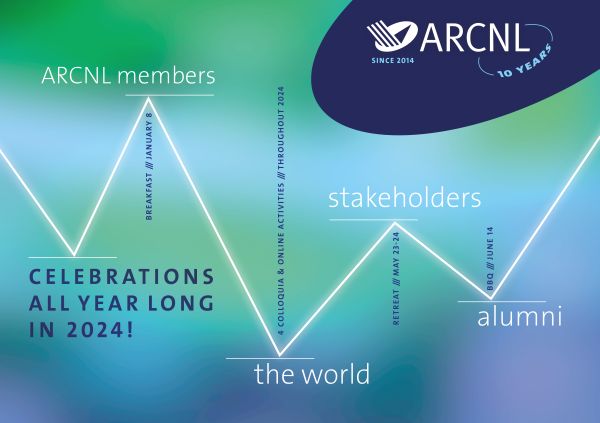 |
| Festivities - ARCNL 10th anniversary |
|
|
| This year is special to ARCNL. It marks the 10th anniversary of our research institute; a decade in which ARCNL has grown into a full fledged NWO-I research institute. In January, celebrations kicked off with breakfast for all researchers and support employees; those responsible for current successes. In May, external stakeholders joined this group for a two-day retreat. In the course of the past ten years a substantial group of researchers were part of the ARCNL community. They will all be invited to return for a joint alumni BBQ. |
|
|
|
|
|
| Funding for Lyuba Amitonova |
|
|
| Lithography machines used for computer chip production are expected to greatly benefit from flat optical components. ARCNL group leader Lyuba Amitonova and a group of collaborators have been given the opportunity to develop these components using the prestigious Perspectief grant from NWO. The budget for this project is 3.1 million euros. Do you want to know more about what advantages flat components bring to the table? Click the button below. |
|
|
|
|
|
|
|
|
|
| Shadowgraphy technique sheds new light on vapors |
|
|
| Extreme Ultraviolet (EUV) light is used in the latest lithography equipment. ARCNL researchers in the group of Oscar Versolato continuously search for ways to make this process more efficient. Their latest approach is to vaporize tin without creating a plasma right away. To find out what happens at the level of individual atoms they used shadowgraphy imaging techniques. Curious to read what the photos showed them? Click on the button below! |
|
|
|
|
|
|
|
|
|
| Historic study |
|
|
| ARCNL's 10th anniversary calls for reflection. One of the approaches ARCNL has taken is to turn to academia. Historian of science Hein Brookhuis has been appointed by ARCNL partner University of Amsterdam (research group of Professor Jeroen van Dongen) to write about ARCNL’s history and to put the organization in an historical perspective. His work is expected to take one year. |
|
|
|
|
|
|
|
|
|
| SEP evaluation |
|
|
In November 2023, an external evaluation committee chaired by Professor Guus Rijnders (University of Twente) visited ARCNL. The committee recently shared its report in which it praises the unique model of ARCNL: bridging the gap between fundamental research and practical applications. The committee was deeply impressed that so much success has been achieved in such a relatively short period of time. Read the full report using the button below.
|
|
|
|
|
|
|
|
|
|
| Creating patterns in the metal ruthenium with lasers |
|
|
Lorenzo Cruciani (ARCNL/UvA PhD researcher) discovered a new method to directly write patterns of ruthenium with a laser. The metal ruthenium is of interest for the semiconductor industry as a possible replacement of copper as a nanoscale conductor. Since this new laser writing method does not require the use of photoresist, it is an easy way to create patterns. Click the button to find out how it works.
|
|
|
|
|
|
|
|
|
|
Highly Charged Ions
Conference |
|
|
 |
2 - 6 September 2024 |
|
 |
Egmond aan Zee |
|
|
|
The biennial international HCI (Highly Charged Ions) conference series will come to the Netherlands for its 21st edition. Central to the conference series are the physics of highly charged ions.
TO REGISTER CLICK READ MORE BUTTON!
|
|
|
|
|
|
|
|
|
|
|
|
|
|
| |
|
|
Science Park 106
1098 XG Amsterdam
The Netherlands |
|
|
|
|
 |
| ARCNL is a public-private partnership between NWO, the University of Amsterdam, the Vrije Universiteit Amsterdam, the University of Groningen and semiconductor equipment manufacturer ASML, and managed by the Netherlands Foundation of Scientific Research Institutes (NWO-I). ARCNL’s mission is to focus on fundamental physics and chemistry in the context of technologies for (nano)lithography, primarily for the semiconductor industry. |
|
|
|
|